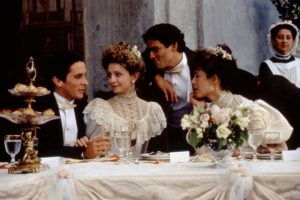WSJ Historically Speaking: The Tragic Side of Weddings

Weddings are happy affairs. What could possibly go wrong? From left, Christian Bale, Calista Flockhart, Dominic West, Anna Friel in 1999’s ‘A Midsummer Night’s Dream.’ PHOTO: FOX SEARCHLIGHT/EVERETT COLLECTION
If April is the cruelest month, then June is the happiest—at least for those hoping to say “I do.” Surveys show that in America, about 16% of all weddings occur in June, making it the most popular wedding month. In many parts of the country, flowers are at their peak and the weather is perfect. What could go wrong?
A great deal, it turns out. With so much riding on the day, weddings occupy a curious place in the human psyche, wedged somewhere between the heights of ecstasy and the depths of despair. The notorious “Red Wedding” episode a few years back in HBO’s “Game of Thrones,” in which the host Lord Frey massacres his helpless guests, may have pushed the envelope in terms of good taste, but its bloody denouement came as no surprise to lovers of tragic opera—or the classics.
The ancient Greeks regarded weddings as potentially very dangerous. Too much happiness was thought to incur the wrath of the gods. Only a prodigious number of sacrifices could stave off disaster, and even then the slightest mistake could upset all the careful preparations. A wedding day transformed into a funeral was a stock theme in Greek mythology and poetry. In one version of the Trojan War narrative, Iphigenia, the daughter of King Agamemnon, walks to the altar dressed as a bride, unaware that she is about to be killed to appease the goddess Artemis, who had held up the warriors’ voyage to Troy.
Many cultures have linked weddings with death, often in the form of a bridal dirge about saying farewell to the family. In China, bridal mourning endured up until modern times. According to custom, the bride, about to be thrown to the mercies of her mother-in-law, spent her final three days of freedom cursing and crying. Supported by her female kin, she sang a series of kuge (“weeping songs”) and hunge (“marriage laments”) for the death of her old, happy self.
The idea of wedding mourning never caught on in America, although Consuelo Vanderbilt wasn’t too far off with her uninhibited display of misery before her marriage (arranged by her mother) to the Duke of Marlborough in 1895. On the day, the reluctant bride cried so hard that the ceremony had to be delayed, it is said, until her face returned to normal.
Of course, it isn’t just women who have regarded their wedding day with a sense of impending doom. Lord Byron managed to put his off for six weeks until he ran out of excuses and married Annabella Milbanke on Jan. 2, 1815. His deep gloom was so contagious that as the couple drove away, Byron’s best man, John Cam Hobhouse, recalled, “I felt as if I had buried a friend.”
At least Byron had remained sober, unlike King George IV, who was so drunk during his wedding to Princess Caroline in 1795 that he could barely stand. The monarch compounded the insult by leering at his mistress, Lady Jersey, throughout the entire ceremony. The marriage, like Byron’s, was not a success.
But all is not lost for those of us who began planning for the Big Day back in elementary school. We can still take heart from Shakespeare’s confidence that all’s well that ends well in a wedding; or two (“Much Ado About Nothing”), or three (“A Midsummer Night’s Dream”), or even four (“As You Like It”). Especially when the goddess Juno, whose name is reflected in this month, “sings her blessings upon you” (“The Tempest”).
